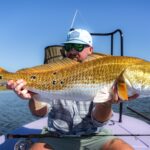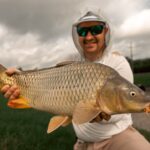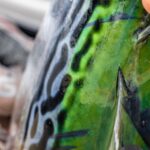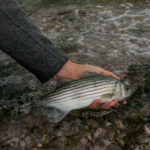
Louisiana Bull Reds Up for Harvest Again: H.B. 604 Must Not Pass
Photo Credit: Carter Abramson | Trevor Johnson Every now and then, we encounter something so
Feature Photo: A school of menahden captured by Tim Regan.
The fisheries space has been busy since the Atlantic States Fisheries Commission Summer Meeting concluded last week. The ASGA team has been all over the map, involved with Mid-Atlantic Council meeting, North Carolina False Albacore Rulemaking, and expanding our cooperative tagging efforts. More on all of that in the coming weeks. As expected, there weren’t many “holy sh**” moments at this ASMFC Summer meeting, but there were some noteworthy developments summarized here:
STRIPED BASS
This section requires its own blog. We will have a standalone piece in the next few days…
MENHADEN
As we alluded to in our preview blog, there was a substantive discussion about Chesapeake Bay menhaden management. Tony and Will from ASGA team were glued into this meeting and shared their thoughts on a rapid reaction podcast, which you can LISTEN TO HERE. The meeting began with a presentation from U.S. Geological Service Biologists, who have been studying osprey in the Bay and elsewhere around the Country. While Osprey have significantly increased their numbers in the Bay, these biologists are observing a concerning downward trend in specific local populations and measures of reproductive success. Now, as a disclaimer, there are so many various factors that can influence osprey reproduction, including prey (food) availability, competition, breeding experience, and environmental conditions.

The USGS Osprey data presentation spurred a strong Menhaden Board discussion and “Possible Chesapeake Bay Menhaden Management.” Maryland’s Lynn Fegley wasted no time and proposed the following motion:

Ms. Fegley’s motion was designed to develop closure options for the largest purse seine vessels during the times of year most important for osprey reproduction and fledgling survival. “In Maryland we are seeing many signs of stress in the Chesapeake….we believe it is commonsense to alleviate stress where we can control it.” From what we gathered, much of Maryland’s motion was due to commercial menhaden fishermen in Maryland not catching any menhaden in MD waters.
The discussion that followed was highly nuanced. There were several comments in support of doing something precautionary with Atlantic menhaden. Dennis Abbot of New Hampshire, a regular voice of wisdom and conservation at ASMFC, added “We should be getting ahead of this problem, and we’ve waited too long…this gets us off the ground to do something…I think in whole we have done very little for the benefit of menhaden and people in the Chesapeake Bay region. I think the time has come to do something.”
Menhaden Board Member Allison Colden of the Chesapeake Bay Foundation added “this translates to a tremendous change to the predatory demands on the Chesapeake Bay’s menhaden population, and that necessitates a reevaluation of our approach to menhaden management in the Bay.”
But there was also some fair opposition, mostly on procedural reservations. Some of these comments included concern about doing something this specific before new stock assessment next fall and fear that this motion was too prescriptive to accomplish tangible conservation in the Chesapeake Bay.
A motion from Pat Geer of Virginia to delay this motion was put forward and fortunately failed.
Then, Menhaden Board Member Allison Colden of the Chesapeake Bay Foundation, put forward a motion that provides a different path for doing something with Chesapeake Bay menhaden management.

The Menhaden Board approved this unanimously. We are looking forward to tuning into these workgroup meetings AND for a final report at the October Meeting. Something needs to be done about menhaden in the Bay. New management must be developed and considered methodically, and this motion does that. It is a win for the bay, menhaden, and all the predators and fishing communities dependent on healthy menhaden populations.
COBIA
The primary agenda item for the Coastal Pelagics Board was to approval a final alternative for Addendum II to the Atlantic Cobia Fishery Management Plan. You can read more on this subject in the Cobia and Meeting Preview Blogs. However, the gist of this addendum is that cobia are incredibly difficult for MRIP (recreational fishing data) to capture, are shifting quickly due to climate change, and all of this is frustrating management. ASGA had advocated for a Coastwide recreational allocation framework, which would’ve been the most compatible scheme given the very real cobia data limitations of MRIP, but it would’ve put southern states in a bit of a regulatory (management measures) bind.
After much discussion, and motions to delay (several southern Board Members had to attend the meeting virtually because of Hurricane Debbie, but this document has been out for a while), the Board approved a regional allocation scheme that sets two regions for cobia recreational allocations: RI-VA and NC-GA over a specific timeframe. Kudos go out to Virginia’s Shanna Madsen, who has been the guiding voice for improving Cobia management and addressing many of the challenges facing this fishery.

The results of the 2024 Atlantic Herring Management Track Assessment were shared, and the results are “devastating,” as Megan Ware of Maine noted. The stock remains overfished (26% of target biomass), struggling to rebuild, poor recruitment continues, and historically low quotas.
ATLANTIC HERRING STOCK ASSESSMENT

These were the main decision points and discussions from the ASMFC Summer 2024 meeting. As we alluded to earlier, lookout for a deep dive into striped bass management in the coming days. We’ll review some of the discussion points from this meeting and what’s coming up for the Annual ASMFC Meeting in October.
Any questions? As always, we’re here for you. Email us at: comments@saltwaterguidesassociation.org.

Photo Credit: Carter Abramson | Trevor Johnson Every now and then, we encounter something so

This past weekend, ASGA proudly sponsored the Dirty Carp Tournament in Louisiana — and no, you didn’t misread that.

After years of data pouring in from The Albie Project, advocacy, persistence, and support from

This morning, the Connecticut Environment Committee held a hearing on House Bill 6248, a bill
We rely on our members and donations to keep fighting for a sustainable tomorrow in marine conservation.
GIVE THE GIFT OF FISHERIES CONSERVATION THIS HOLIDAY SEASON. SHOP ASGA GOODS THAT FUND FISHERIES RESEARCH & ADVOCACY CAMPAIGNS
JOIN ASGA IN CALLING FOR CRITICAL MANAGEMENT ACTION AFTER YEARS OF SPAWN FAILURES & POOR MANAGEMENT.
By using this website, you agree to our use of cookies. We use cookies to provide you with a great experience and to help our website run effectively. To learn more, please review our privacy policy.